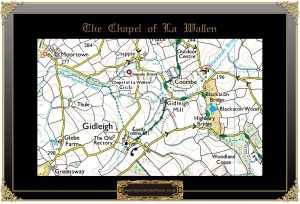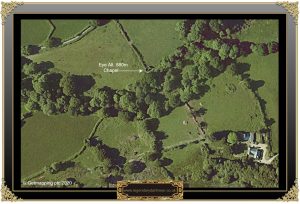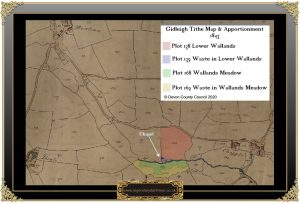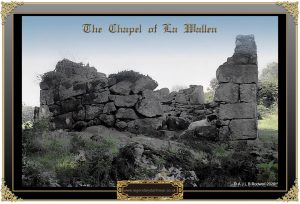
Anybody who has read the book or watched the film of, ‘The Name of the Rose’ will not be surprised at anything medieval monks got up to. Dartmoor has its own version in the, ‘Mad Monk of Gidleigh’, well to be exact, ‘The Mad Monk of Haldon’ but as the story began at Gidleigh that is where it can stay. The amazing fact of this tale is that its true and is documented in the Register of Bishop Grandisson of Exeter.
The story begins sometime in the 1200s when a small, private chapel was built just outside Gidleigh, it became known as the, ‘Chapel of La Wallen’ and was dedicated to the Blessed Virgin Mary. Incidentally, it has been suggested that the term, ‘La Wallen/Walland’ is an early Norman descriptive of a walled area of a field. During this period it was often the practice for nomadic monks to install themselves in such chapels in order to say daily masses and generally maintain the building. Robert de Middlecote was one such monk and on the 28th of March 1328, did, according to the Bishop’s Register, ‘mistreat Agnes at the small chapel’. Agnes was the daughter of Roger the Miller whose mill was located near to the Chapel of La Wallen. Seemingly, Alice was pregnant and Robert de Middlecote somehow murdered her unborn child and if that is what was deemed as, ‘mistreatment’ I dread to think what actual murder must have been. The monk was duly indicted for trial infront of Thomas de Chageforde, the King’s Justice but somehow he managed to escape before any trail took place. It seems that Middlecote headed for the coast as there are reports of several houses being burgled in the coastal area of the river Teign, householders claimed that money and food had been taken. A few weeks later the monk was apprehended somewhere on Haldon Hill which is a few miles south west of Exeter. Following his capture Middlecote was given the nickname of, ‘The Mad Monk of Haldon’ and this was obviously due to the location of his capture. He obviously knew his law because as a monk Middlecote claimed benefit of clergy which at the time meant he had opted to be tried by canon law and not secular law. Usually this meant a much more lenient sentence being handed down by the ecclesiastical court and so it seems was the case here. A trail was set for the 1st of June 1328 and that was the last documented record of Robert de Middlecote. It may well be that the trial took place and Middlecote managed to convince the court that his accusers were committing perjury or even the monk managed to escape custody and flee for his life. There is a possibility that his case was hushed-up and he was sent to another area, perhaps his guilty burden was so heavy that he committed suicide, nobody knows. What is known is whatever the outcome it displeased the folk of Gidleigh because the tiny chapel was desecrated and left abandoned in the same year.
Apart from what happened to Middlecote the other burning question is why did he commit such an awful crime? Had he broken his vows of chastity and the unborn child was his? Did the monk consider the woman had conceived the child out of wedlock and administer some kind of divine justice for her sins. Or, was he mad and in a moment of insanity attack the girl? This story was the inspiration for Michael Jecks’ medieval murder mystery – The Mad Monk of Gidleigh which was published in 2002. I can thoroughly recommend this book if you would like some ‘flesh’ put on the original story as it adds a plethora of images to the tale.
I have come across a description of one man’s discovery of the chapel back in 1921 which reads:
“Almost opposite Gidleigh Pound, facing the Throwleigh road, is a gate which opens on to the old Church path connecting Gidleigh village with the other or N.W. side of the parish known as Moortown. By following this path through three fields we arrive at an ancient stone stile which admits us to the first of the Gidleigh Wallands, its correct name being ” Walland Meadow.” There is little in its present condition that would suggest a meadow, for here, nature, for a considerable time, has been permitted to run wild. On the left we look upon a small picturesque glen through which falls the gurgling Chapple Brook, while on the right, bushes, brambles, and tall bracken grow in such density it is almost impossible to find a way through. Yet behind this jungle effectually hidden from our view—on the other side of the brook—is an interesting ruin which was doubtless once used for religious purposes.
Continuing our journey across ” Wallands Meadow ” and over the stepping stones of the brook—the old clapper bridge of which was broken years ago—the path now leads us to slightly rising ground with a field wall close on our right. This wall forms the boundary of our second Wallands, for behind it lies ” Higher Wallands,” while the field beyond, towards Chapple, is “Lower Wallands.” A few yards further on the Church path brings us to a gate which opens upon a cart road connecting Moortown and Chapple. The road runs almost parallel with the Chapple Brook, the space between being occupied by the Wallands’ fields till we reach Chapple, consisting of two farms named East and West Chapple, but in an ancient charter of the Earl of Mortain, called Chapellond. By following this road a short distance the gate of ” Lower Wallands” is reached, in which field our ruin is situated.
In design the ruin is oblong, the ends occupying positions almost due East and West. Its South and North walls which rise to the height of about 8 feet, are nearly three feet in thickness, and consist of massive granite stones, which, with the exception of the corners, are simply undressed boulders. At the South-East corner the stones are squared and are similar to those used in the tower of Gidleigh Church. In the South wall and near the East end, the stones have fallen down, leaving a wide space, but the window nearly opposite to this in the North wall is fairly intact. This window is square, four feet from the ground, the measurement being 4 feet high by 3 feet 8 inches wide. The small window in the East wall is interesting. Its height is about 3 feet, the base is one foot 10 inches wide, narrowing toward the head to one foot 6 inches. The flat stone which forms the head of the window is supported by two upright stones which form the sides of the window.Though very primitive in design and rude in execution this window lends quite an ecclesiastical effect to the building. The outside measurement of the South wall from East to West was found to be 26 feet 6 inches, while the width of the structure was 14 feet. Curiously enough the North wall measured from East to West only 21 feet. Another peculiar feature of the ruin which bore witness to the fact that for generations it had remained undisturbed was that the interior is occupied by 6 oak trees, five of which are fully grown and attain the height of between 35 and 40 feet. Measured two feet from the ground they vary in girth from 4 feet 7 inches to 2 feet 7 inches. As silent sentinels these oak trees have guarded and protected the sacred place during the long period it has remained neglected and forsaken by its lawful custodians. Even the ivy growing over the end walls has attained the proportion of trees, some of the stems measuring 6 inches in thickness… Probably this ingenious farmer’s intention was to convert the ruin into a useful linhay or cattle shed, but someone, I can well believe, discovering his sacrilegious designs, interfered, and in order to prevent any future desecrations of the place, had the interior planted with oak trees, and the walls hidden by creepers.” Rawson, pp 129 -138.
It has been suggested that the chapel was desecrated sometime between 1328 and 1332, additionally the oak trees inside the building are now long gone. The ruin can be found at Ordnance Survey grid reference SX 6693 8893
The above is the Dartmoor version of affairs and as far as Middlecote was concerned once he left the area – good riddance to ee. But there is another part to the story once he had moved to the Exeter area, according to local tradition the monk found himself another chapel from whence he could perform his ministerial duties. Lidwell chapel was located in a very remote spot just north-west of Teignmouth near the farm of Lidwell. It is said that the name derived from the ‘Lady Well’ which was associated with a holy well near the chapel. Supposedly, by day, Middlecote appeared as a very devout man of God and served those attending the chapel with compassion and caring. By night however he would go in search of weary travellers and offer them food and shelter at his chapel. He would then prepare them a meal that was laced with a soporific drug and once unconscious he would then butcher his victims with a knife and after robbing them of any valuables dump their bodies down the well. For several years he murdered and robbed unwary travellers until the day he chose a sailor as his next victim. As he was about to attack the man with his knife the sailor managed to see the approaching onslaught and fended him off. After a violent struggle Middlecote ended up being tossed down the well and whilst trapped down their the sailor summonsed help from the nearby farm and the monk was hauled out and handed over to the authorities. It has been suggested that there are some historical documents that record how Middlecote was hanged from the Exeter gallows in 1329, another version of his demise was that he died down the well.
If this story is correct then it would fill in the missing blanks which appear in the Dartmoor version, namely that he died one way or another in 1329.

Croxford, C, A, 2002. A Walkabout Guide to Gidleigh. Chagford: Gidleigh Parochial Church Council.
Rawson, J. 1921. The Chapel of La Walland – Devon & Cornwall Notes % Queries Vol. XI. Exeter: J. Gommin
 Legendary Dartmoor The many aspects past and present of Dartmoor
Legendary Dartmoor The many aspects past and present of Dartmoor





No Left Hand Column and no Pastscape link Tim. I’ve been on Pastscape and not found any image of the chapel. I’ll have to get up there and take a look for myself.
I happend upon this place with my then husband around 1995 . I remember walking down quite a steep hill . I was also a lot fitter in my youth so the walk back up was fine . I remember it had a very musky smell and very overgrown . I would like to revisit to see how much more nature has claimed it . I’m guessing this place isn’t found upon that often . I plan to take my youngest boy there to investigate . As my now husband has no interest of anything out of the ordinary . I’m.sure my son will pull me back up the hill .certainly not out of the well. Good luck in your search Peter 😊
Visited the Chapel a few months ago; very overgrown and boggy exterior. It looked inadvisable to get too close in its current state (let alone struggle through the brambles etc.
Great story . Tried many years to find it but intend to try again.
Locating the chapel is not too difficult once you find the copse in which it is located. Unfortunately, it is now a single wall of which, a stream runs through the door and down the middle of what would have been the chapel, meaning that the ‘earth’ floor, is extremely boggy. This may not be so much the case in the Summer months.
If you are disappointed by your find, the small woodland to it’s right has a beautiful spiritual ambience and well worth spending a little contemplative time inside.
The best route I feel to arrive at the ruined chapel is to park at the ‘doorway’ of the public footpath on the road that connects Luscombe Hill and Higher Exeter Road. There is space for two vehicles here. Use this path, which orientates in a pure south direction until you reach the end, of which there is a vehicle track. Take a left here and follow this path for a short while until it splits into two, and take the thinner right branch, which takes you into a small woodland, at the bottom of this woodland is a gate, which opens up into an open field. Stay to the left of the field and you will see the entrance to the chapel half way down the hill. I would advise to return back to your car using the same route and not to find a new one out of the woodland, if you choose to spend time there.